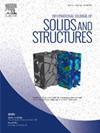固体变形引起的流势的数值计算
IF 3.4
3区 工程技术
Q1 MECHANICS
International Journal of Solids and Structures
Pub Date : 2024-09-21
DOI:10.1016/j.ijsolstr.2024.113080
引用次数: 0
摘要
当固体在外力作用下发生变形时,会导致其内部孔隙中的液体流动并产生流势。为了解孔隙中的流势,提出了固液流势耦合数值分析模型。为了验证该模型,设计了一个实验,并通过与实验结果和理论分析结果的比较分别证明了该模型的可靠性。然后,应用该模型分别对不同曲率的带状通孔和弯曲孔管中的流势进行了数值计算。结果表明,在相同的外部载荷下,直锥形管内的流势随管出口直径的减小和细管长度的增加而增大。另一个结果是,弯曲细管或孔的曲率也会导致流势增加。加载频率也会影响流势。相对较高的加载频率会导致流势振幅增大。本文章由计算机程序翻译,如有差异,请以英文原文为准。

Numerical calculation for streaming potentials caused by solid deformation
When a solid is deformed by an external force, it will cause the liquid in its internal pores to flow and generate a streaming potential. To understand the streaming potentials in the pores, a numerical analysis model of solid–liquid-streaming potential coupling was proposed. To validate the model, an experiment was designed and the reliability of the model was demonstrated by comparing with the results of the experiment and a theoretical analysis respectively. Then the model was applied to numerically calculate the streaming potentials in tubes with tapered-through-hole and curved holes with different curvatures respectively. The results show that under the same external loading, the streaming potentials in a straight tapered tube increases with the decrease of tube outlet diameter and increase of the thin tube length. Another result is that the curvature of a thin bent tube or hole can also cause the increment of the streaming potential. The loading frequency also affect the streaming potential. Relatively high loading frequency results in increasing the amplitude of the streaming potential.
求助全文
通过发布文献求助,成功后即可免费获取论文全文。
去求助
来源期刊
CiteScore
6.70
自引率
8.30%
发文量
405
审稿时长
70 days
期刊介绍:
The International Journal of Solids and Structures has as its objective the publication and dissemination of original research in Mechanics of Solids and Structures as a field of Applied Science and Engineering. It fosters thus the exchange of ideas among workers in different parts of the world and also among workers who emphasize different aspects of the foundations and applications of the field.
Standing as it does at the cross-roads of Materials Science, Life Sciences, Mathematics, Physics and Engineering Design, the Mechanics of Solids and Structures is experiencing considerable growth as a result of recent technological advances. The Journal, by providing an international medium of communication, is encouraging this growth and is encompassing all aspects of the field from the more classical problems of structural analysis to mechanics of solids continually interacting with other media and including fracture, flow, wave propagation, heat transfer, thermal effects in solids, optimum design methods, model analysis, structural topology and numerical techniques. Interest extends to both inorganic and organic solids and structures.

 求助内容:
求助内容: 应助结果提醒方式:
应助结果提醒方式:


